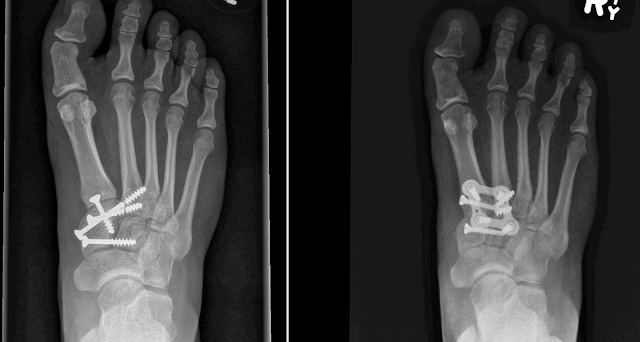Dr. Christopher Lu MBchB FRCSC / Darryl Yardley M.Sc.PT / Niyati Shah M.Sc RS
Lisfranc fusion post-op protocol
PRE-OPERATIVE PHYSIOTHERAPY:
- Advice in regards to improving fusion outcomes: stop smoking, decrease alcohol intake, ensure adequate amounts of vitamin D drops (2000 u / day) + calcium in diet, use of bone stimulator
- Purchase: crutches, knee walker, cast protector
- Assess with AOFAS midfoot scale
- If you are interested in pre-operative physiotherapy and a pain management consult please call
Restore Physiotherapy Georgetown - 905-702-1840
- This rehab protocol has been designed to minimize potential complications.
0 - 6 WEEKS:
- Patient immobilized in a short leg cast and can mobilize using crutches / knee scooter / iwalk 2.0
- Use cold therapy for pain relief
- Non-weight bearing
- Keep cast clean and dry
- Leg elevation for edema control
- Can take aspirin 325 mg, once a day while immobilized in cast - for DVT prophylaxis - if there are no contraindications / allergies.
- Staple / suture removal and wound check at 2 weeks post-op.
- Change to new short leg cast after suture removal.
6 - 12 WEEKS:
- Can weight bear on heel in short cast boot
- Start physiotherapy
- Can use cold therapy unit
- Active ankle ROM in pain free range
- Include dorsiflexion, plantar flexion, inversion and eversion
- Ankle circles
- Ankle alphabets (trace alphabet in air with foot)
- Proprioception non-weight bearing exercises / kinesthetic awareness
- Wiggle toes / toe stretches / pick up marbles with toes
- Straight leg lifts + side lifts / non-weight bearing strengthening exercises
- Stationary recumbent bike with more work on weight bearing extremity / use cast boot initially for 1st week / gradually ween out of boot
- Passive ROM - rear foot mainly, soft tissue work on tibialis anterior / peroneals / FHL / EHL / tibialis posterior
- RMT for swelling and scar tissue mobilization when wounds have healed
- TENS, IFC, NMES, hydrotherapy, wax therapy and ice as needed.
- Isometric (hold / relax ankle movements) can start at 10 weeks post-op
3 - 6 MONTHS:
- Patient now full weight bearing
- Gait retraining
- Wean off crutches / cane / cast boot / resume normal walking
- Ankle ROM with weights
- Weight bearing proprioception exercises
- Theraband ankle movements
- Heel-toe raises
- Active calf stretch and active tibialis anterior stretch
- Lunges / Stepping - ensure patient has pain free weight acceptance on affected side.
- Passive ROM to improve ROM
- Modalities as need, RMT as needed
6 MONTHS +:
- Running if tolerated and done before surgery / Treadmill
- Trial of HOKA one running shoes
- Fitting for custom orthotics
Discharge with full ROM and ankle / foot muscle strength 4+ /5 / Pain free movements
Assess with AOFAS midfoot scale at 6 weeks, 12 weeks, 6 months and 12 months.
Disclaimer: This physiotherapy protocol is specifically designed for patients who have had their Lisfranc fusion performed at Georgetown Hospital. We routinely perform our fusion using a locking plate + screw construct instead of screws alone. This provides a more rigid construct. As such, we allow early heel weight bearing.

























































